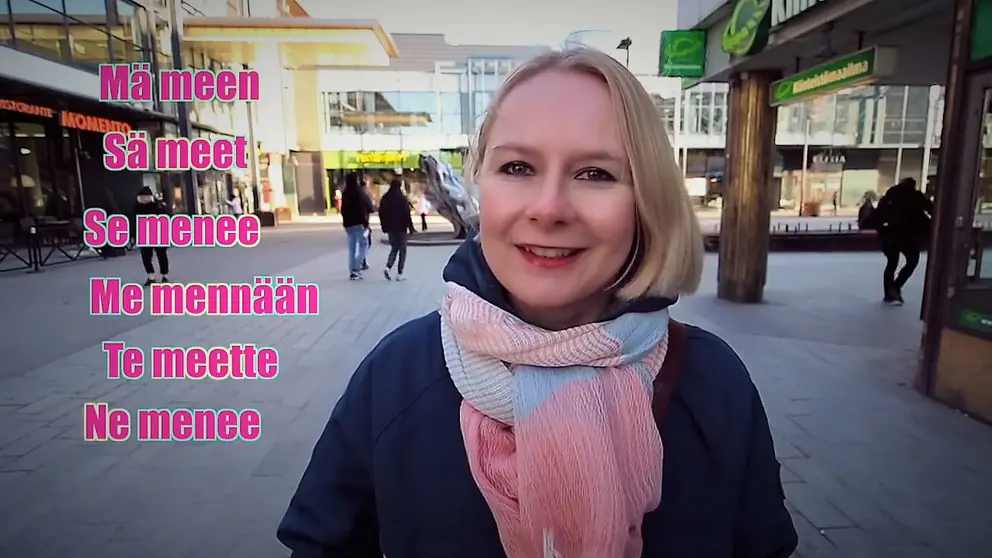In this lesson you will learn some expressions of spoken Finnish. Maybe you have noticed that spoken Finnish can be a bit different from the official, standard Finnish. It is important to learn to understand spoken language. Remember though that you can always speak standard Finnish.
Let’s start with numbers. In spoken language some numbers have shorter forms:
- Yksi (1) becomes 'yks'
- Kaksi (2) becomes 'kaks'
- Viisi (5) becomes 'viis'
- Kuusi (6) becomes 'kuus'
As you can see, the last letter i disappears.
Numbers kahdeksan (8) and yhdeksän (9) are pronounced without letter 'd':
- 'Kaheksan'
- 'Yheksän'
When you are talking about tens, you need a short form for the word kymmentä: 'kyt'. In spoken Finnish tens are usually:
- 'Kakskyt' (20)
- 'Kolkyt' (30)
- 'Nelkyt' (40)
- 'Viiskyt' (50)
- 'Kuuskyt' (60)
- 'Seitkyt' (70)
- 'Kaheksankyt' (80)
- 'Yheksänkyt' (90)
You will hear numbers in spoken language for instance when you go to a grocery store. The sum can be for example 'kakskytkuus viiskyt' (26,50) instead of kaksikymmentäkuusi euroa, viisikymmentä senttiä.
Also some of the personal pronouns have shorter forms in spoken language. Minä (I) is 'mä' and sinä (you) is 'sä'. Sometimes we use pronoun 'se' instead of hän (s/he), but beware: se can be impolite in some situations. He (they) is usually replaced by the pronoun 'ne'.
The verbs
Now let’s look at verb conjugation. Me and he forms (we and they) are different in spoken language. In written Finnish you would say me syömme or me asumme (we eat, we live), but in spoken language the passive voice is used with the pronoun me:
- 'Me syödään'
- 'Me asutaan'
When you conjugate a verb in the third person plural form (they), in written language, the verb ends with -vat or -vät. For example he syövät, he asuvat (they eat, they live). But in the spoken language you don’t really hear that. Instead, the verb is the third person singular form:
- 'Ne syö'
- 'Ne asuu'
There are also some verbs that look quite different in spoken language. For example the most important verb, olla (to be). It is conjugated as follows:
- 'Mä oon'
- 'Sä oot'
- 'Se on'
- 'Me ollaan'
- 'Te ootte'
- 'Ne on'
Compare to the written forms:
- Minä olen
- Sinä olet
- Hän on
- Me olemme
- Te olette
- He ovat
Here is another verb conjugated in spoken language: mennä (to go):
- 'Mä meen'
- 'Sä meet'
- 'Se menee'
- 'Me mennään'
- 'Te meette'
- 'Ne menee'
The same conjugation in written language would be:
- Minä menen
- Sinä menet
- Hän menee
- Me menemme
- Te menette
- He menevät
One more verb in spoken language: tulla (to come):
- 'Mä tuun'
- 'Sä tuut'
- 'Se tulee'
- 'Me tullaan'
- 'Te tuutte'
- 'Ne tulee'
In written language:
- Minä tulen
- Sinä tulet
- Hän tulee
- Me tulemme
- Te tulette
- He tulevat
Now you know in what ways the spoken Finnish and the written Finnish are different. The examples in this lesson are used in Helsinki and its surroundings. In other parts of Finland the spoken language can be different.
Please remember that you can always use the standard Finnish.
The video and dictation exercises
Here is my video about spoken Finnish:
Now you can also practice your listening skills with this dictation exercise:
Well done! If you have followed my lessons from the start, now you have a good basic knowledge of Finnish language. Of course, language learning never stops.
This is my last lesson in this series. I want to thank all of you for reading and watching my lessons. I hope to see you again in the future. Good luck with your studies!











